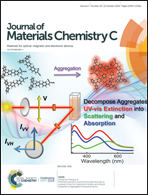Synthesis of solvent-free processable and on-demand cross-linkable dielectric elastomers for actuators†
Abstract
Dielectric elastomer actuators (DEAs) have gained growing interest during the last decade from both the scientific community and industry. However, the high operating voltages needed to drive these actuators reduce their application potential. To date, several reports have been published on high permittivity elastomers that can be operated at low electric fields; however, little attention has been given to their processability into thin films and reliability as dielectrics in actuators. This work presents the synthesis of low molecular weight polar polysiloxanes, which have low viscosity and can, therefore, be processed into thin films by the solvent-free doctor blade deposition technique. Additionally, the prepared polysiloxanes have vinyl end-groups which are subsequently used for cross-linking into thin films, where multifunctional thiol cross-linkers and a UV initiator are used. The prepared films are elastic and show a permittivity of about two times higher as compared to commercial polydimethylsiloxane elastomers. In addition, their elastic modulus is easily tuned between 1.2 and 0.4 MPa using a dithiol as a chain prolongation reagent, while their viscoelastic behavior is comparable to commercial silicone elastomers. When used as dielectrics in DEAs the developed elastomers allow reliable operation over 180 000 actuation cycles at reduced voltages.



 Please wait while we load your content...
Please wait while we load your content...